|
The Life, Legacy and Furniture of George Nakashima
And a Conversation with Mira Nakashima
|
by Mike McLeod, Editor
Posted August 2015

ŌĆ£We are left in awe by the nobility of a tree, its eternal patience, its suffering caused by man and sometimes nature, its witness to thousands of years of earth's history, its creations of fabulous beauty. It does nothing but good, with its prodigious ability to serve, it gives off its bounty of oxygen while absorbing gases harmful to other living thingsŌĆ” Its fruits feed us. Its branches shade and protect us. And, finally, when time and weather bring it down, its body offers timber for our houses and boards for our furniture. The tree lives on.ŌĆØ1
George NakashimaŌĆÖs philosophy reflected his style of craftsmanship: earthy, unexpected, creative, often symmetrical and asymmetrical in the same piece of furniture, elegant and definitely unique. His work, which often incorporates slabs of irregular tree trunks or roots, is highly recognizable and appreciated.
|
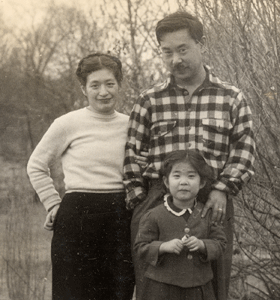
|
George Nakashima was born on May 24, 1905 in Spokane, Washington. His parents moved to America from Japan, and both were from the lineage of samurai.
After earning a bachelors degree in architecture, Nakashima studied in France for a time before returning to America and earning a masters degree, also in architecture, from M.I.T. He then traveled internationally and was hired by an architectural firm in Tokyo. One long-term project involved his overseeing the building of an ashram dormitory in India. There, he became a disciple of the ashramŌĆÖs leader Sri Aurobindo, and he also began to design furniture.
|
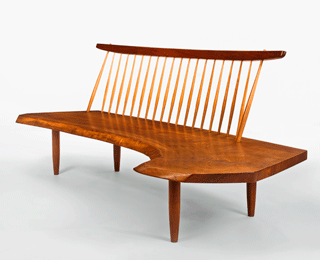
|
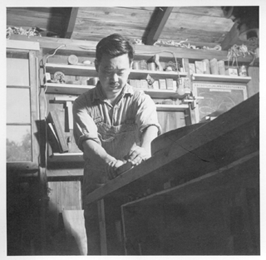
|
|
Circa 1980 Conoid Bench of American black walnut, East Indian rosewood and hickory, 32 x 84 1/4 x 35.5 inches, sold by SothebyŌĆÖs New York for $25,000 on June 9, 2015. (Photo, courtesy of SothebyŌĆÖs.)
|
George Nakashima in his workshop.
(Photo, courtesy of Nakashima Foundation for Peace,
www.nakashimapeacefoundation.org.)
|
ŌĆ£My father grew up in Seattle and was a boy scout,ŌĆØ GeorgeŌĆÖs daughter Mira Nakashima explained to me recently. ŌĆ£He often went out by himself in the mountains and felt a wonderful sense of peace there. [At the ashram,] he found the philosophy he was looking for in life. There are different types of yoga, beside the physical discipline, and this philosophy was the yoga of doing (Karma Yoga). It gave him the strength and courage to do what he did.ŌĆØ
At the outset of World War II, George Nakashima returned to America and married Marion Okajima, settled in Seattle and had a daughter, Mira. A son, Kevin, joined the family after World War II.
|
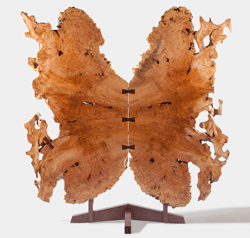
|
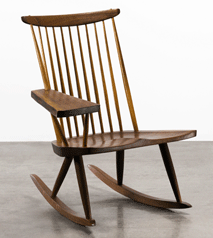
|
|
a fantastic George Nakashima book-matched set of Maple Burl Roots tsuitate, or space divider. (Photo, courtesy of George Nakashima Woodworker, S.A., New Hope, PA, www.nakashimawoodworker.com)
|
Single-Arm "New" Rocker of American black walnut and hickory, 1980, sold for $4,375 by SothebyŌĆÖs New York. (Photo, courtesy of SothebyŌĆÖs.)
|
In the year following Pearl Harbor, the Nakashimas were sent to a Japanese internment camp in southern Idaho. In Camp Minidoka, George met and was tutored by a carpenter trained in traditional Japanese woodworking. There, he learned attention to detail and to strive for perfection, even under the difficult circumstances of a lack of available wood.
Mira Nakashima was only six months old when her family was relocated to the high desert of Idaho. Mira has no memories of being in the camp at that young age, particularly since her family left after about a year.
ŌĆ£When I went back to the site of the camp, I didnŌĆÖt remember it specifically, but I felt like IŌĆÖd been there before,ŌĆØ Mira said.
While visiting, she met a farmer who had employed her father to tend his field of carrots. The farmer related how George Nakashima told him with tears in his eyes how grateful he was for the job. The farmer was happy to have men from the camp who worked so hard and were happy to work.
The farmer also told Mira how the camp authorities required him to drive out each day to pick up the work crew and then drive them home at dayŌĆÖs end. After a while, the farmer gave his keys to the men and told them to drive themselves. He was tired of the back and forth; obviously, George and the men in the crew had gained his trust.
Not much remains today of the camp that was 3.5 miles long and one mile wide. During the war years, it held a total of 13,000 people, about 9,000 at its height. Camp Minidoka had 44 housing blocks, each block with 12 barracks. A barrack measured 20 feet by 120 feet and was home to six housing units.2
The camp was not fully constructed when the internees began to arrive, but every housing block eventually had a mess hall, laundry facility, bathrooms and a recreational hall that was used as a school, for worship services and for community events. The camp had libraries, cooperative stores, a hospital, theaters, a warehouse, barbershops, a watch repair shop, nine baseball fields and swimming in an irrigation canal.3
The climate in the Idaho desert was brutalŌĆöhot summer days, cold nights, heavy snow in the winter, and volcanic desert dust blowing almost constantly and covering everything. It was reported that sometimes the dust storms were so heavy darkness fell on the camp.4
To many today, these hardships pale in comparison with the civil rights that were lost. However, in light of the recent controversy surrounding the Allen Eaton Collection of internment art that was going to be auctioned, 5 Mira shed a different light on the internment camps in American history: ŌĆ£The angriest people were not those interned; it was the next generation who werenŌĆÖt there themselves. It was blown up to be a civil rights thing, but it was an overreaction. Those there just accepted it as thatŌĆÖs the way it is. They came here to America to be free,ŌĆØ and ironically, internment in a camp was the price they paid to show their patriotism.
|
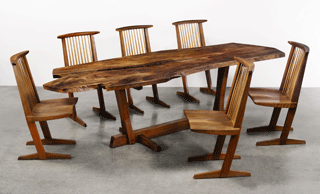
|
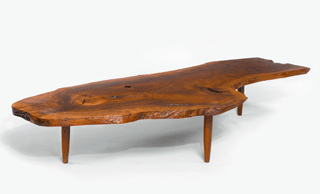
|
|
Circa 1965 Conoid Dining Table of American black walnut and East Indian rosewood, 28.5 x 106.75 x 42.5 inches, $143,000. Set of six Conoid Dining Chairs of American black walnut and hickory, 35.5 x 20 x 20.5 inches, circa 1980, $40,625, Dec. 18. 2013, SothebyŌĆÖs New York. (Photo, courtesy of SothebyŌĆÖs.)
|
Circa 1973 Slab Coffee Table of American black walnut and East Indian rosewood, 13.5 x 81.5 x 34 inches, circa 1973, $32,500 by SothebyŌĆÖs New York. (Photo, courtesy of SothebyŌĆÖs.)
|
Some families were able to leave the camps as they found sponsorships or by invitation from friends in other parts of the country. Surprisingly, the majority did not leave Camp Minidoka until they were forced out before it closed on Oct. 28, 1945. There were several reasons why most wanted to stay: some older people did not want to be a burden on their children; others feared racist violence after the war; others had no home, job or business to return to; some feared repatriation to Japan, which was advocated by some politicians for internees they thought were still loyal to Hirohito; and others had lost confidence in their ability to survive on their own without government assistance.6
Seeking to redress some of the wrongs, the Civil Liberties Act of 1988 provided about $20,000 to every surviving Japanese-American internee.
In 1943, George and his family were released due to the efforts of his former employer from Tokyo, Antonin Raymond. The Nakashimas moved to New Hope, Penn., where they lived and worked on RaymondŌĆÖs farm. From there, George NakashimaŌĆÖs philosophy of furniture came to fruition and eventually to acclaim.
GeorgeŌĆÖs discipleship in the ashram and education in Camp Minidoka heightened his innate skills and aesthetic to yield a style of functional beauty. Avoiding ostentation, his furniture found beauty in purity while highlighting the character of the wood, particularly its gnarled imperfections. His ŌĆ£yoga of doingŌĆØ found the perfection in imperfection.
|
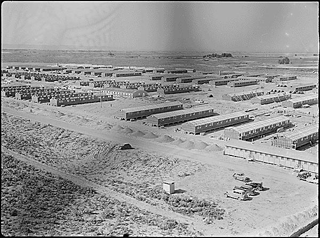
|
Camp Minidoka in Idaho where George Nakashima and his family were interred during World War II.
|
ŌĆ£When he first started out and was working with a Japanese carpenter, he used found materials around the camp and bitterbrush from the desert,ŌĆØ Mira recounted. ŌĆ£When he came back here, he didnŌĆÖt have money for good wood but got cutoffs from the lumber industry and went from there. After Dad was able to get these cutoffs, he made friends with loggers in the area and got trees others didnŌĆÖt want; then he oversaw the milling to get the right direction and thickness.ŌĆØ
Why does George NakashimaŌĆÖs craftsmanship captivate people? ŌĆ£Because it is different. My father integrated life and work by not tying into the big-corporation mindset of mass production and making money. To him, it was more important to make beautiful furniture; money would come later. He combined utilitarianism with beauty.
ŌĆ£I had a tour group through this morning, and they said they felt peaceful here and felt the furniture was alive,ŌĆØ Mira said. ŌĆ£Dad always felt he was giving trees new life, and life continues. Not everybody understands this; itŌĆÖs not for everyone, but if you are sensitive to it, you will sense life in each item we make. People realize this when they have sold their Nakashimas. ItŌĆÖs like selling a part of themselves.ŌĆØ
ŌĆ£I feel that there is a spirit in trees thatŌĆÖs very deep. I am somewhat of a Druid that wayŌĆ” I do feel that in order to produce a fine piece of furniture, the spirit of a tree lives on. I can give it a second life, as something like the medical profession. But I think this is in a way even more realistic and deeper than what the medical profession can do because I can make an object that lives and can live forever, possibly, if used properly. So thatŌĆÖs my objective and thatŌĆÖs my happiness to find this relationship with a tree.ŌĆØ7
George NakashimaŌĆÖs sense of beauty continues to enthrall collectors. His work graces the homes of Steven Spielberg, Brad Pitt, Julianne Moore and many others.8 A Nakashima Conoid Bench, Conoid Chair, Lounge Chair and Minguren II Coffee Table are preserved for history in the Smithsonian.
In 2006, a Nakashima redwood burl and black walnut dining table sold for a stratospheric $822,400 at SothebyŌĆÖs.9 After the stock market crashed in 2008, prices reset, but they are again on the upswing. In 2012, fashion designer Diane von Furstenberg bought a 14-foot Nakashima dining table for $130,500 at a Phillips, de Pury & Luxembourg auction.10
|
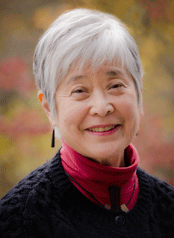
|
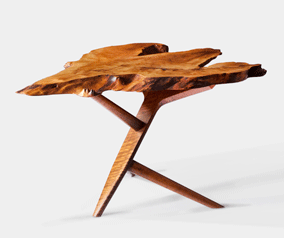
|
|
Mira Nakashima. (Photo, courtesy of George Nakashima Woodworker, S.A., New Hope, PA, www.nakashimawoodworker.com.)
|
Conoid cross-legged end table. (Photo, courtesy of George Nakashima Woodworker, S.A., New Hope, PA, www.nakashimawoodworker.com.)
|
Today, Mira continues the family tradition of woodworking and furniture making, and she has written a book about her father called Nature, Form and Spirit: The Life and Legacy of George Nakashima. Of her fatherŌĆÖs influence, she said, ŌĆ£Today, there is a strong legacy that lives all over the world in using the natural form of wood. The architecture he created on the property here [his workshop, studio, and home in Bucks County, Pennsylvania] now is a Historic National Landmark. Another landmark in his life was to leave the camp in the desert and start a legacy here in New Hope.ŌĆØ
Coming from a generation embroiled in war, George Nakashima desired peace for the world. ŌĆ£My father had a dream to make Peace Altars for the world. If people could meet around them, we could get a little closer to world peaceŌĆ”sitting or standing around one has a unifying affect.ŌĆØ
He planned to build seven Altars of Peace (which are large tables), one for each of the seven continents. Three Altars of Peace have been installed thus far: one in the Cathedral of St. John the Divine in New York City; another in the Russian Academy of Art in Moscow; and a third in Auroville, in Pondicherry, India, an offshoot of the Sri Aurobindo Ashram where George was a disciple at one time. A fourth is planned for Capetown, South Africa at the Desmond Tutu Peace Centre. The New York Altar of Peace is made from two matching walnut planks; it measures 10.5 x 10.5 feet and weighs more than 1,000 lbs.
George Nakashima passed away on June 15, 1990 in New Hope, leaving the world a legacy of beauty and a hope for peace.
------------------------------------
1 George Nakashima Woodworker, Nakashimawoodworker.com.
2 Historic Resource Study, Minidoka Interment National Monument by Amy Lowe Meger, NPS.gov, Colorado State University, pp. 100-101.
3 Ibid, pp. 149-151.
4 Ibid., p. 147.
5 Artwork, photos and artifacts from internment camps scheduled to sell at a Rago Auction earlier this year was canceled due to protests by internees and their descendants. George Takei (ŌĆ£SuluŌĆØ on Star Trek), a board trustee of the Japanese American National Museum and who was interned in two camps as a boy, was instrumental in seeing the collection acquired by the museum. See LA Times article, ŌĆ£George Takei helps L.A. museum acquire internment camp artifacts,ŌĆØ by Deborah Vankin, May 2, 2015, www.LATimes.com.
6 Historic Resource Study, Minidoka Interment National Monument by Amy Lowe Meger, NPS.gov, Colorado State University, p. 146.
7 ŌĆ£Interview with George Nakashima,ŌĆØ courtesy of Jim Bunn with assistance from John Nakashima, and www.nakashimawoodworker.com.
8 New York Times, ŌĆ£Antiques: A Reverence For Wood And Nature,ŌĆØ by Wendy Moonan, November 2013.
9 Blouinartinfo.com, ŌĆ£On the ŌĆśParticular DestinyŌĆÖ of Designer George Nakashima's Craft Woodworking,ŌĆØ by William L. Hamilton, November 26, 2012.
10 Ibid.
|